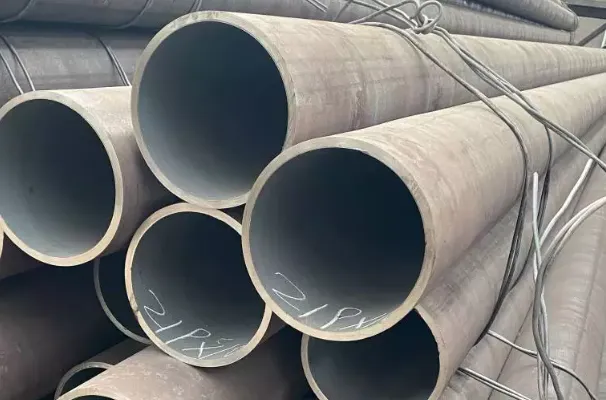As concerns about the environmental impact of human activities intensify, the steel industry's reliance on fossil fuels is facing increasing scrutiny. The service life of low-carbon steel pipes is generally around 20–50 years, depending on the environment and protective measures: in dry, indoor, low-corrosion environments, they can last for decades with almost no significant degradation; however, in humid, acidic, alkaline, or high-salt-spray corrosive environments, without coatings, anti-corrosion paints, or galvanizing, the lifespan may be shortened to 5–15 years. Therefore, the lifespan of low-carbon steel pipes is mainly determined by environmental corrosivity, the quality of anti-corrosion treatment, and the application scenario. Low-carbon steel pipes stand out as a more sustainable alternative, with a longer service life than traditional steel pipes, and due to their smaller environmental impact during production, they contribute to the transition to a low-carbon economy.
Definition and meaning of low carbon steel
Low carbon steel (mild steel) is a carbon steel with a carbon content of less than 0.25%. It is also called mild steel because of its low strength, low hardness and softness. It includes most ordinary carbon structural steels and some high-quality carbon structural steels. Most of them are used for engineering structural parts without heat treatment, and some are used for mechanical parts that require wear resistance after carburizing and other heat treatments.
The annealed structure of low carbon steel is ferrite and a small amount of pearlite. Its strength and hardness are low, and its plasticity and toughness are good. Therefore, it has good cold formability and can be cold formed by curling, bending, stamping and other methods. This kind of steel also has good weldability. Low carbon steel generally refers to steel with a carbon content between 0.10 and 0.25%. This type of steel has low hardness and good plasticity, which is convenient for cold plastic deformation forming, welding and cutting. It is often used to make chains, rivets, bolts, shafts, etc.
Average Lifespan of Low Carbon Steel Pipes
On average, low carbon steel pipes last between 20 to 50 years, depending on usage conditions. In ideal indoor or dry environments, their lifespan can exceed 50 years, especially when coated or maintained regularly. However, in corrosive environments—such as underground installations or exposure to chemicals and moisture—lifespan can significantly decrease to 15–25 years without protective treatments.
Here's a quick overview of expected lifespans in different conditions:
|
Environment
|
Expected Lifespan
|
|
Indoor (Dry, Climate-Controlled)
|
40–50+ years
|
|
Outdoor (Moderate Climate)
|
25–40 years
|
|
Underground (No Coating)
|
15–25 years
|
|
Corrosive/Marine Environments
|
<15 years (unless treated)
|
|
With Galvanized/Zinc Coating
|
40–70 years
|
Factors That Influence Lifespan of Low Carbon Steel Pipes
1. Corrosion Exposure
The biggest threat to low carbon steel pipes is corrosion. Exposure to water, oxygen, acidic environments, and chemicals accelerates rust formation. Without protective coatings or proper insulation, pipes will corrode faster, leading to thinning walls, leaks, and structural failure.
2. Coating and Surface Protection
Protective coatings such as galvanization, epoxy lining, paint, or oil-based anti-corrosion treatments can greatly extend the lifespan of
carbon steel pipes.
Galvanized steel pipes, for example, can last 50–70 years under suitable conditions.
3. Environmental Conditions
Soil type, humidity, temperature variation, and presence of salt or chemicals in the air or ground all affect pipe longevity. Pipes in marine or highly humid areas degrade faster than those installed in dry inland locations.
4. Maintenance Practices
Routine inspections, cleaning, and timely replacement of damaged sections can extend the operational life of steel piping systems. Neglected pipes, even in relatively mild environments, can fail prematurely.
5. Pipe Thickness and Diameter
Thicker pipes tend to last longer as they take more time to corrode through. Pipe diameter also influences structural integrity, especially in high-pressure systems.
How to Extend the Life of Low Carbon Steel Pipes
Extending the lifespan of low carbon steel pipes involves proactive protection and care. Here are some effective strategies:
Use of anti-corrosion coatings like zinc (galvanized), epoxy, or polyethylene layers.
Cathodic protection for buried pipes to prevent electrochemical corrosion.
Proper installation techniques that avoid mechanical stress and moisture entrapment.
Regular maintenance and inspections to catch early signs of wear or corrosion.
Avoiding contact with dissimilar metals to prevent galvanic corrosion.
Conclusion
Low-carbon steel pipes offer a solid balance between strength, versatility, and cost. While their typical lifespan ranges from 20 to 50 years, factors like environmental exposure, protective treatments, and maintenance routines play a critical role in determining actual longevity. By investing in proper care and quality products, you can ensure that your low-carbon steel piping system performs reliably for decades.






 English
English Español
Español بالعربية
بالعربية











 Phone :
Phone :  Whatsapp :
Whatsapp :  Email :
Email : 


